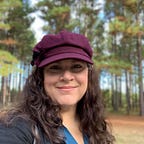Is Play The Thing? Or is it One of Many Things? Let’s Have a Chat About that New Preschool Study…
NPR recently published an article highlighting some really important research that raised some interesting questions about what effective learning in preschool should consist of. You can read NPR’s article here, and the original study the article is based on here.
However, I’m actually concerned that the NPR article is promoting the wrong message from the study (I.e., kids just need to play more). Let me explain…
One of the big factors the Durkin et al. (2022) study raises is the amount of time spent on transitioning (e.g., moving children from one activity or location to another), and the fact that a lot of public preschools, housed in elementary school facilities, are not designed with “little bodies” in mind. This leads to developmentally inappropriate expectations being placed on 3 and 4 year olds in terms of the self-regulation needed to navigate these transitions, as well as lost learning time.
Another interesting thing that the NPR article points out is that “parents of means” send their kids to more play-based environments (think Waldorf, Reggio, or Montessori etc) — environments that are designed with little bodies in mind. However, that’s not the whole story. We know that parents with higher education and SES levels also, on the whole, provide more enriching home environments and spend more time incorporating learning talk and learning activity at home. These early home experiences with foundational concepts and skills help children enter school environments with higher levels of prior knowledge.
This happens much less often for children from low ses homes. They often have not had as much exposure to early math and reading topics, which leads them to enter school with extremely low levels of prior knowledge. Essentially, not ready to learn from the instruction that formal schooling provides. This may cause a bit of an over-emphasis (maybe even an over-reaction) from the schools causing them to lean in heavily on more formal kinds of activities (think worksheets or overly explicit / direct instruction) as a response. Yet, much of the research on young children’s learning confirms that more positive effects tend to occur with informal instruction than with formal instruction. This is compounded by the fact that early childhood teachers are frequently not well trained to work specifically with the youngest learners (most are trained in early elementary), nor do they have the content area knowledge or pedagogical expertise to do so — another point the researcher of this article called out…
The NPR article also noted that Durkin et al. (2022) identified the problem of local control versus state control. This is also born out in the research literature. Not all kids need or benefit from the same kind of early care and education. But if a program is standardized at the state level, they are going to deliver the same program to all the children in the state, irrespective of individual needs or learner variability. That’s why, I suspect, more locally controlled programs see more success. Local programs are more likely to know their families and children. It’s also why private preschools see a lot of success (among other reasons). Small private schools really know their children and families, and respond to their individual needs. This is another reason to be critical of (not against, but just critical of) universal preschool. Do all children need early care and education? Yes in some form or other — but what form that takes should be highly individualized for the benefit of the learner.
I’ll say one last thing that was NOT mentioned by this article. The article makes mention of the Perry Preschool Study and the ABCDarian preschool projects, both of which were used to fuel the work of Nobel Laureate Dr. James Heckman. The article failed to mention that one of the reasons these programs resulted in such astonishing life-time learning and economic gains for the preschool children was because the program adopted a whole child, whole family appproach. These programs didn’t just work with the child, they also worked directly with mothers and other family members to increase their knowledge of early childhood development and care, and how to best support all the needs of their growing child, mental, emotional, physical, and cognitive. The children in these studies were from some of the lowest ses populations as well. Not only did they see effects for the preschool children in the study, but positive ripple effects extended to the siblings of the preschool children as well. Teaching a mother benefits all the children in the household.
I’ll close by saying this… the problem of how to appropriately structure early care and education is a complex one with many compounding factors ranging from learner variability, differences in home environments and families, lack of high quality teacher preparation, lack of funding, and more. Solving this problem requires approaches that involve ALL stakeholders working through all these factors simultaneously. Just addressing one area or factor will not result in appreciable change (see Bloom’s Four Objects of Change, 1984). And that’s the reason I take issue with the headline for this article. The answer is not just to let kids “play more”. Far from it — though more play may be PART of a whole child, whole family, whole community solution.
This is a critical problem to solve and everyone should care about it whether they are parents or not. Everyone should care because the long-term effects of strong, effective early care/education programs impact all of society in terms of intellectual capital, economics, informed citizens and more. In fact, successful early ed programs have the potential to return $13 for every $1 spent to our economy over the life time of an individual. Now that’s a solid investment.
